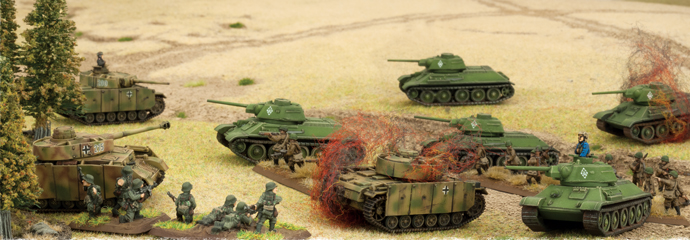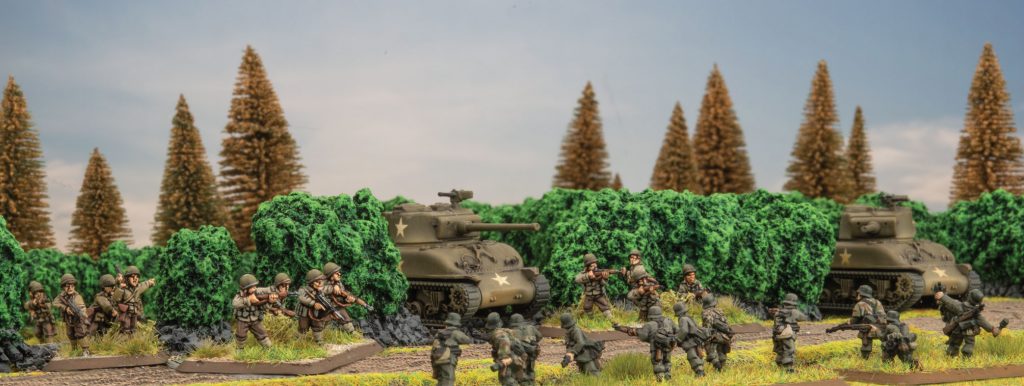|
|
 |
|
|
The Art of Reserves
|

|
The Art of Reserves
with Jed Byrtus
Reserves in Flames Of War can often be misunderstood. “It’s a huge disadvantage in missions where you have to defend”, or “The Attacker has such an advantage, I only get 60% of the force they do!”
Well, what if I told you that I often get excited for reserves? That the reserves in Flames Of War is just as much an advantage for the prepared player as it is a disadvantage for the unprepared one? You might call me crazy, but I firmly believe that having reserves can be a huge advantage.
|
|
The Fundamentals
The fundamental part of reserves that makes them look bad is the fact that they’re not on the table. They are not contributing for the first few turns, they can’t kill anything or force your opponent off an objective. What magnifies this is that you’re not really sure when they are going to show up. This seems bad for you, our defender, but if you take a second and think of it from your opponents point of view, it can be bad for them too.
If a unit is not on the table, the attacker can’t destroy it. Add onto this the ambush, and the defender has about 50% of their force that is literally indestructible in the attacker’s first turn. When these forces do end up coming on, they come on full strength and can strike at the opponent before they get attrited. Not only do they strike first, they get to strike unexpectedly and often from an advantageous position.
|
|
The attacker doesn’t know when that reserve unit is going to come on, and they don’t really know where it’s going to come on. They know the area reserves come on, and they know the odds of you getting reserves, but the exact details are iffy. This means your opponent has to either, stay away from the board edge and risk not taking the objective in time, or come in close and risk getting assaulted or flanked.
You can generally tell whether or not they’re going to do one or the other, or even a combination of both, during the attacker’s first turn. Watch the way your opponent moves their models, are they being aggressive or cautious? The best employment of your reserves depends on what your opponent is doing, so take note of how their troops are moving when you roll.
|

|
|
On the Table
So it’s turn 2 or 3 and some of your reserves have shown up. The first thing I always look for is the closest enemy units to the board edge. If there is the chance for an assault right from the board edge it should tempt you. There’s very few things as scary as an infantry assault, and they can reach enemies up to 16 inches from the board edge. In some missions that’s your whole deployment zone. A tank assault can go even further, up to 18 inches, and can hit almost as hard. You don’t have to unpin, and it will be a full strength platoon conducting the assault. Don’t be afraid to assault tanks with your infantry either, some smoke, a bailed vehicle, and some clever placement and you can rout a tank platoon with an infantry platoon that just walked onto the table.
|
|

|
|
Let’s say you don’t have any good assault options, the next thing to look for is flanking options. This isn’t just about getting those tasty side armour shots on tanks that got a little too overzealous and charged way too far forward (though that is nice), it’s also about forcing your opponents tanks to back off from the assault or risk being flanked. You don’t necessarily have to get the side shots right away, the threat of getting side shots the next turn can be enough to take your opponents attention away from the objectives.
And if your opponent has stayed back and hopes to shoot you out of your foxholes, maybe delay your reserves. I know you have to bring in a unit when you get a unit, but you can either bring in a tiny unit like some recce vehicles, or you can bring on your bigger platoons somewhere in the back and keep them as an on table reserve for when the attacker finally comes forwards. If the attacker needs to get close to an objective by defender’s turn 6, and a big unit showed up on defender’s turn 3 or 4, then the pressure is on. The attacker has to start getting close right away and the defenders haven’t been attrited because they haven’t been on the table.
|
|

|
|
Before the Game
In order to use these reserve strategies, you need to have your reserves properly prepared. If you find yourself scrambling at the table after you’ve rolled for a mission trying to decide what your reserves will be, you’re already on the back foot. List building is the best time to think about what you’ll put in reserve, whether or not you plan on defending. Keep in mind the number of points that you need to put in reserve and try not to go too far over. From the fundamentals of and uses of reserves that we discussed, we can deduce some key features of units you want in reserve.
We discussed that reserves are indestructible for the first few turns. Because they’re indestructible anyways, you don’t have to pay all those points to make them hit on 4+ or to give them a ton of armour. If they’re only going to be on the table for 2 or 3 of the opponents shooting phases, they don’t need to stand up to as much fire as the rest of your force. Take U.S. Sherman 76s for example. 5 Veteran Shermans is 5 points more expensive than 5 Trained Shermans. On the turn they come in, they act much the same because they have the same skill in assault and the same number of shots. In that key turn where you get reserves, that extra 5 points is getting you nothing, so why pay for it?
|
|

|
| This brings me nicely to the second thing that makes for good reserves: good firepower. You will only have these reserves on for a few turns, they’re going to have to make a difference right away. Every point you save on survivability can go into more firepower or a stronger assault. A good example of this is the Ranger Platoon. The Rifle teams in this platoon hit on 2+; the Bazookas and even the mortar hit on 3+! Because they are Aggressive, you don’t pay a ton of points for a unit that hits like a ton of bricks.
The Rangers also have another benefit that you want to consider with reserves: mobility. While infantry is a little slow, they can cross any terrain with ease. Tanks can be a little faster, but they can get stuck in forests. If you want to take full advantage of your reserves your troops have to get into the fight fast. Avoid slow moving tanks and guns for sure, but also consider the unit’s cross ratings. The classic Panzergenadiers really shine here and when I play Germans they often find themselves in reserves. They’re fast with a good cross in their halftracks, and can go through anything on foot. They hit well in assault and, if you add on some panzerfausts and panzershrecks, they can threaten anything.
|
| The last thing I want to talk about when it comes to composition of reserves is what I like to call timing units. You have to bring something on if you rolled that 5+, but that thing can be anything. I like having a small unit worth only a couple points in my reserve just in case I get 1st turn reserves and the timing isn’t quite right. You can use this little platoon to shore up some weak defenses while you wait for your opponent to fall into your trap. After that though, when your opponent is in range, you want to hit them hard and fast. That’s when having large units worth lots of points is important. A combo I like is 10 T-34s with 5 T-34(85)s, and 3 T-70s. You can bring on the T-70s first if you’re not ready for the counterattack, then smash the attack with your T-34’s. You can also do the reverse if you get late reserves. Smash the attack with 10 T-34s then push your opponent off the objective with the T-70s. That little extra unit can help a lot with perfectly timing that counterattack. |
|
Hooray for Reserves
Hopefully this has given you something to think about, reserves don’t have to be a bad thing. When so many people are saying it’s an attacker’s game you can really throw someone off by standing and fighting. Using your reserves properly is a defining feature of a good defense. Planning ahead will make sure you’re prepared when inevitably you run into a mission where you have reserves. You might find yourself bidding defend and maybe, just maybe, you’ll get that crazy look in your eyes and that knowing smirk when you see that you get to have reserves.
~Jed
|
|
|
|